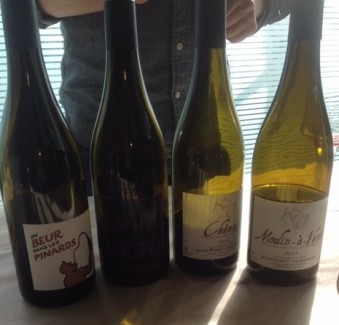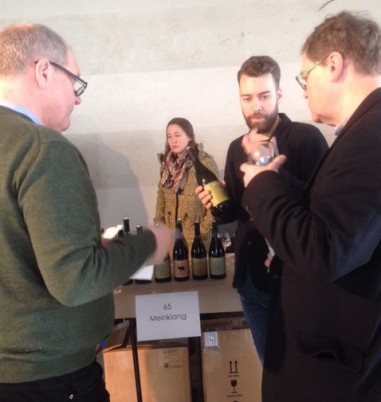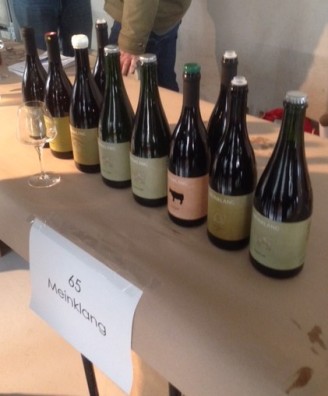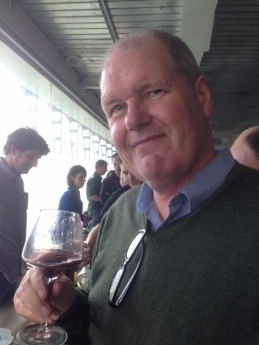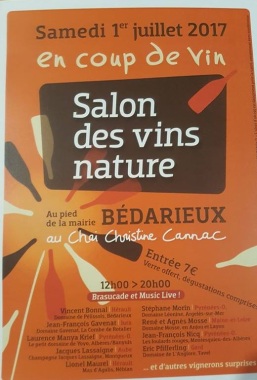
It was good to be able to attend a local tasting after being in NE England for so long, I’m afraid they are rare in my home region. Christine Cannac runs a wine bar, which offers good food too, in Bédarieux. These sort of caves/restos are to be found all over France and are my favourite eating places of my time in France. Places such as Christine’s, Cave St Martin (Roquebrun), Pas Comme Les Autres (Béziers) and Picamandil (Puissalicon) offer good wines with quality food in the Languedoc. Not to mention Verre Volé and Cave Insolite in Paris, Aux Crieurs in Troyes and the peerless Papilles Insolites in Pau. Highly recommended.
Christine organised a dégustation of some of her producers as she regularly does. There were 9 winemakers present and they offered a high standard of wine.
Domaine Léonine (Roussillon) had some very good red wines with my favourite the Bottle Neck, a full, complex combination of Grenache and Syrah with plenty of fruit and power.

Bernard talking with my friend Vincent
Domaine Plageoles (Gaillac) is a domaine rightly renowned for its quality, pioneering work and championing of local and old grape varieties. Bernard Plageoles was present and it was good to chat with him. The Mauzac Nature 16 seems richer than usual and truly delicious. However, his Contre Pied 16, made from Duras was my highlight. Made to be drunk young it is refreshing, light, fruity with typicity of the grape and its dusty aromas.

Domaine Mosse (Anjou) offered bright, clear Chenin wines. The highlight was the Rouchefert with round, full apple and honey notes, a wine which will develop for many years.
Yannick Pelletier (St Chinian) is a regular on these pages. His wines are always good, often excellent with concentrated fruits, local character and very drinkable. As so often Engoulevent was my favourite, classic St Chinian notes of dark fruit and lovely depth.
Mas D’Agalis (Hérault) is a long term favourite too, Lionel Maurel offered Yo No Puedo, perhaps his most famous wine. Largely Carignan but with Syrah,Grenache and Cinsault it is classic Languedoc and the 2016 has really come together from when I tasted it in Montpellier in January.
Domaine Yoyo (Roussillon) with yields of less than 10hl/ha in places has serious wines and features one of my favourite grapes, Grenache Gris. However, it is made into a light and darker red by maceration on skins. Both are very good but the lighter La Vierge Rouge is a favourite, lots of red fruits with power and a refreshing finish.

Léonine (left), Foulards Rouges served by Laurence Manya Krief who makes Yoyo wines
Les Foulards Rouges (Roussillon) is another well known producer. I really like Glaneurs, pure Grenache with dark, complex fruits and a clean, refreshing finish.
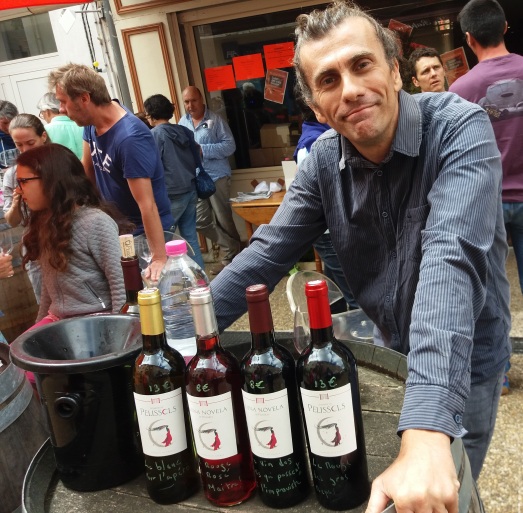
Justifiably proud Vincent
Domaine De Pélissols (Bédarieux), the local boy done good. Vincent Bonnal has really upped his game and these were very good wines. I liked everything, would happily drink his Luna Novela red at any time. However, star was the clairet style rosé. 36 hours maceration gives the Grenache (and tiny amount of Syrah) time to extract a deep colour with a depth of flavour to match. Lots and lots of fruit, not many wines will be more suited to the Languedoc summer, a real success.
Champagne Jacques Lassaigne (Montgueux near Troyes). I first tasted Lassaigne champagnes at the aforementioned Aux Crieurs in Troyes and have sought them out since. Pure Chardonnay they are wines of pure fruit, concentration, complexity and sunshine in a glass. Jacques was present and I loved his Blanc De Blancs from 10 parcels, La Colline with added complexity from the barrel ageing and the blend of 2010, 2011 and 2012. Star though was the vintage 2008. Such power, fruit; pleasure for the palate and mind. I have been lucky enough to enjoy some fantastic champagnes this year and these rank as high as any.
So, a small friendly tasting with a lovely mussel brasucade to add to the pleasure. If you are in the Bédarieux area seek out Chai Christine Cannac.



